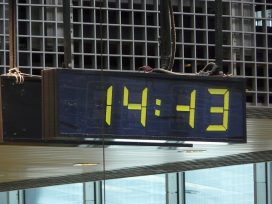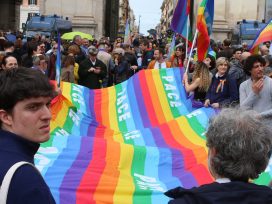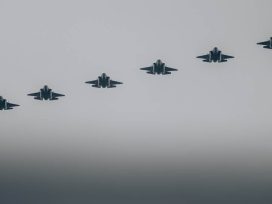The technology of negative mobilization
Russian public opinion and Vladimir Putin's "Ukrainian policy"
How can it be that, in contrast to the international community, virtually no one in Russia believed that Russian-backed separatists shot down the Malaysian Airlines plane in July? Beyond press censorship, Lev Gudkov looks to Russians themselves, who increasingly hear only what they want to. His analysis draws extensively on research conducted by the Levada Center, presented here in numerous tables and graphs.
Over the course of just two or three months, Vladimir Putin’s anti-Ukrainian policy has transformed the social mood in Russia. Any situation that draws society into a state of mobilization reveals the deeper structures and mechanisms of social organization in action. The Ukrainian crisis is no exception. In normal, peaceful circumstances these mechanisms and structures are hidden – even specialists may be unaware of them.1 This idea of Yuri Levada’s makes an important contribution to the understanding of processes taking place in Russia today, that is to say: the sudden surfacing of the primitive mechanisms of collective consolidation around a centre of power, brought about by propaganda. These mechanisms reflect the vestiges of totalitarian institutions and, in the artificially constructed atmosphere of a state of emergency, they determine the responses of the collective consciousness and reanimate the myths, symbols and idiom of the Soviet era, forcing us to reflect on the incompleteness of the processes that dissolved the USSR or the inertia of the communist past.
The plane crash
Reports about the Malaysian Airlines Boeing airliner crash released by news agencies on 17 July left most of the Russian population unmoved. At the time, Russians were still caught up in a state of exhilaration, euphoria and collective pride following the annexation of Crimea. Just 16% noted the disaster in a list of the most important events of the preceding week. Russians were more concerned about an incident in the Moscow metro which had caused a number of deaths, clashes between separatists and the Ukrainian army in eastern areas of Ukraine, western sanctions against Russia, the World Cup, and so on.
However the outrage expressed by the international community, which blamed Russia for complicity in this tragedy, forced the Kremlin to defend itself and the Russian media to give the disaster greater attention. Television, the newspapers with the highest circulation, and other information channels wholly under the control of the presidential administration, fiercely rejected any suggestion of Russian responsibility. Numerous conflicting versions about what had happened broke into the Russian information space. Some were completely absurd2 but nevertheless consistently anti-Ukrainian, which created turmoil in people’s minds and stifled their ability to take a critical view of reported events.
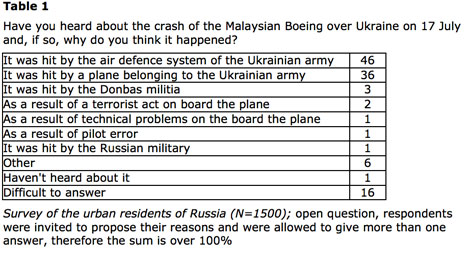
A representative, national public opinion poll taken two weeks later in Russia confirmed the interpretation of events that the Kremlin’s political spin-doctors were seeking to secure in the mass consciousness. There was great public sympathy for the victims, outrage and indignation at the actions of the Ukrainian leadership, and an absence of any sense of guilt or of Russian responsibility for the deaths caused, or for what was happening in Ukraine.
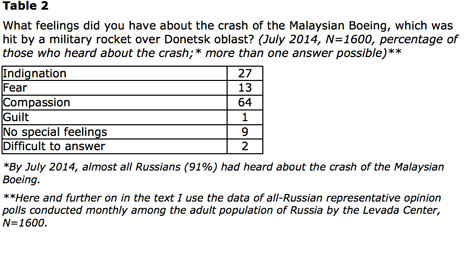
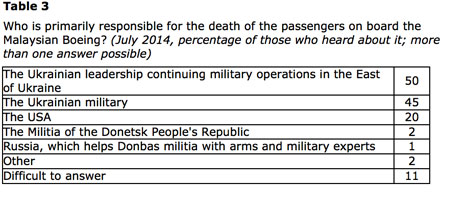
Russians pinned the political and military responsibility exclusively on Ukrainians. Only 1-2% of those polled blamed separatists, supported by Russia, for the crime. Public opinion did not take into account either the looting that had occurred at the site where the airliner crashed, or the obstacles put in the way of international specialists researching the circumstances of the disaster, who were unable to access the area, or recordings of conversations between fighters about the civil airliner they had shot down, or any other undesirable details.
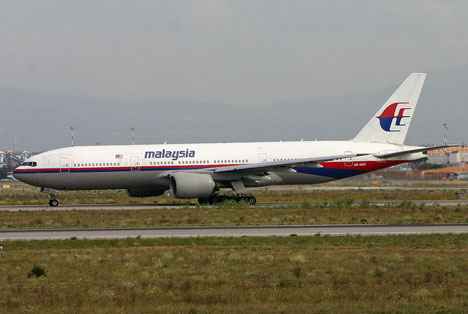
The Boeing 777 involved in the incident, photographed in October 2011. Photo: Alan Wilson. Source: Wikimedia
To some extent this public interpretation of the event can be put down to the fact that information deemed undesirable by the authorities was quite simply not broadcast by Russian television or printed in press publications, which were strictly censored. Sometimes it appeared in the form of a narrative that altered the sense of what had happened. But it seems to me that a more important factor was the stubborn unwillingness of people to hear what they did not want to hear, a conscious resistance to – and selection of – incoming information. From January 2014, discussion of current issues and events became possible only in a few Internet publications and on social media sites still independent of the Kremlin.
The information war
In Russia today, the basic source of information is television. In recent months, previously available alternative television channels have been either closed under various pretexts or neutralized. The construction of reality in the collective consciousness takes place predominantly under the influence of television propaganda, which combines video materials with highly tendentious interpretations and montage, and with intentional falsifications.
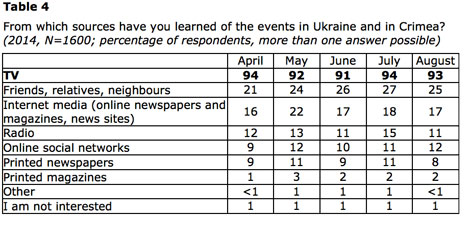
The issue of the effectiveness of the anti-Ukrainian propaganda campaign lies not just in the intensity with which it is being conducted (this is unprecedented in post-Soviet times), but also in the question as to why people are prepared to take it on board. Why do they want to give it their attention? You would have thought that Russians, who had personally experienced the collapse of the Soviet system and who know the price of state-sponsored lies and disinformation, would have developed a mistrust of, or immunity to, propaganda. What had they heard that allowed them to overcome, or more accurately “put in parentheses”, their usual mistrust of official demagogy? Materials from public opinion polls show that a significant proportion of Russians are aware of the tendentiousness of reporting from Ukraine, and conscious of the interest the authorities have in this one-sided presentation. Nevertheless, respondents thought that under the circumstances the authorities were acting correctly and expressing themselves appropriately.
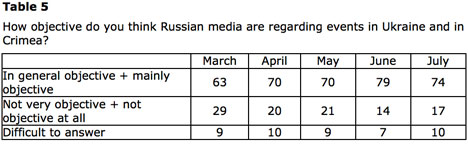
The proportion of doubters dissolved rapidly, until it formed a marginal and bewildered minority, in the face of the increasingly powerful and aggressive collective opinion of the “majority” – its consciousness of being “us”. Propaganda intensified the interpersonal exchange of information. In an overwrought social environment, people frightened by the threat of a large-scale war (the prospect of the escalation of clashes between separatists and regular divisions of the Ukrainian army into a full scale civil war and – to a lesser degree – into a world war) discussed the tendentious reports they had received from television more fully and frequently, which led not to a more critical appraisal of information but to its replication and consequently its dogmatic consolidation in the collective mind. The important thing here is the fact that the “general opinion” formed by the official sphere puts constant pressure on the amorphous and passive consciousness of people who are deprived of alternative communication sources and any interpretation of events independent of the authorities. With its monopoly status, TV is not only the most powerful but the most authoritative of the media. All other channels of information are supplementary to it. I would add that reference to the Internet or to independent publications is primarily in evidence among the populations of larger cities (not villages or small towns, where about two-thirds of the Russian population live). Critical assessment of the administration is declining slowly but surely (see Table 5). Distinctions in the way information is interpreted and assessed – formerly specific to discrete social groups and conditioned by the extent of social capital, levels of culture or education, and access to a range of information sources – have been obliterated in recent months. A year ago, differences in the way events were understood by the populations of megalopolises and in conservatively orientated small towns, for example, seemed significant. Today this is no longer the case. A social consensus has been established in relation to the authorities and their opponents.
In addition, it is important to note that 60% of those polled admit that they cannot understand what is happening in Ukraine. But this does not prevent them from taking up positions in line with the official point of view, since their perception of reality has been shaped according to models imposed by state propaganda.
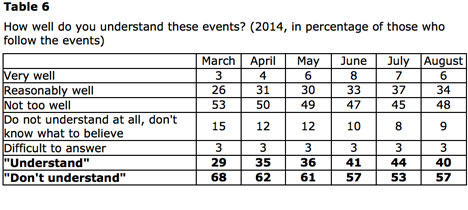
On the other hand, the actions of foreign media (Ukrainian, European, American, etc.), which offer an essentially different interpretation of events in Ukraine and of Russia’s role there, are considered prejudiced, tendentious, hostile and lacking in objectivity. This is the view held by 66% of Russians polled (21% found it hard to judge the quality of media reporting, 14% considered it “objective”).3
To the question: “Do you agree that in recent months the media of the Russian Federation are conducting an information war against Ukraine and if so what is your attitude to this?”, 17% of those polled responded “yes” but said they considered such a policy to be “right and justified by the situation in Ukraine”. 12% agreed but assessed the situation negatively (“a dangerous and harmful policy”). But the majority – 54% of those polled – thought that the media offered an objective picture of events in Ukraine (August 2014).
The Kremlin’s propaganda aims to resolve two problems that represent a hugely serious threat to the Putin regime.
One of these is connected to Ukraine’s withdrawal from the Eurasian Union. Ukraine is the second largest country in the post-Soviet space, after Russia. The fact that events took this course cost Putin dear in terms of his reputation, because they suggested that Russia was an unattractive centre for the consolidation of new states. Even if this was played down, Ukraine’s political change of direction made the rebarbative sides of the Russian regime patently obvious. Consider its pretentiousness (the insistence on Russia’s special role in the world, its status as a unique civilization equal to the West), its repressive and anti-democratic character, the ineffectiveness of a state privatized by a corrupt bureaucracy and oligarchs close to Putin. The prospect of Ukraine’s integration into the EU, even though it might not be imminent, exposed the essence of the Putin project: that is to say the establishment of a union of despotic regimes under the aegis of Russia – a kind of mini-USSR – ensuring its isolation from the global community and the creation of a cordon sanitaire on the edges of Russia and Europe.
A second issue was even more serious, perhaps. The national rebellion against Yanukovich’s corrupt regime (for that is how all events connected with the resistance in the Maidan in Kyiv were perceived by Russian public opinion and indeed the Kremlin administration), together with aspirations to form a law abiding democratic state in Ukraine, created a possible precedent for action on the part of the Russian opposition. Against the backcloth of an increasingly weak regime4 and rising social discontent among many Russians, the Maidan might seem an acceptable model for the destruction of Putin’s plutocratic form of rule. Bearing in mind the scale of the mass protests which took place in 2011 and 2012 in Russia’s largest cities following the falsification of election results, the subsequent unpopularity of the regime and disappointment in the impossibility of achieving any change of government by legal means and democratic procedures, the Kremlin administration’s fear of “the streets” might seem wholly justified.
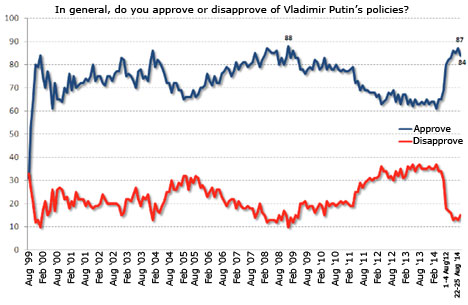
Graph 1
That is why, from January 2014, a full-scale information and propaganda war broke out around events in Ukraine. At the time of writing (August 2014), as far as Russian citizens are concerned, Putin is unarguably the victor.
There are four discernible stages in the campaign, and they can be identified by consistently promoted political arguments.
Phase One: December 2013 – January 2014
The main motif which gradually gained strength in commentaries about events in Kyiv consisted of the statement that the Euromaidan was a link in, or part of, a global series of mass disturbances and socio-political upheavals inspired by the USA, launched with the help of the Internet and social networks, alongside the support and activities of foreign foundations and non-governmental organizations. The essence of the revolutions taking place world-wide was the same, from the “Rose Revolution” in Tbilisi in 2003, the “Orange Revolution” in Kyiv, to the events in northern Africa, the revolutions in Tahrir Square in Egypt, in Istanbul and in Syria. Their purpose was the establishment of quasi-democratic regimes dependent on the West. From the point of view of the Russian population, this simple idea seemed a convincing underpinning for a comprehensive explanation of events. It fell in easily with traditional Russian anti-western sensibilities, Soviet anti-capitalist ideology, paranoid fears of the threat of a world war, and isolationism. That is why, even though this hypothesis had no concrete evidence to support it, it came to be widely accepted as a framework within which events in Ukraine could be explained. 83% of respondents to the survey (of those who had even the haziest notion about the troubles in Kyiv) agreed that mass meetings and demonstrations in Ukraine were inspired and organized (paid for) by the West.
This version of events did not provoke particular anxiety among Russians. The most widespread view was that the economic situation in Ukraine was ruinous. The battle between alternating – and corrupt – political leaders, and parties representing only the interests of competing oligarchic clans, had brought the country’s economy to a dangerous point. The standard of living was twice as low as in Russia and so on. Consequently the drive towards integration with the European Union seemed perfectly justified in the eyes of Russians (especially if one remembers the illusions Russians themselves cherished in the early 1990s, about how the rejection of communism would lead seamlessly to an abundance of consumer goods and an improvement in the standard of living). The policy of the Kyiv government provoked no feelings of aggression or dissatisfaction among Russians. The vast majority of those polled (65-70% during October and November 2013) thought that this was an internal matter for Ukrainians, and that Russia should on no account get involved. Only a clear minority – 29% of respondents – insisted that the agreement on the first stages of union between Ukraine and the EU should be regarded as a betrayal of “Slavic unity” and opposed by any possible means.
Phase Two: February – March 2014
The standoff at the Maidan and Yanukovich’s escape to Russia – after Putin had urged him to crush the opposition by force – prompted a far broader, aggressively intensified , and all-encompassing campaign to spread disinformation among the Russian population. Images of clashes between demonstrators and internal troops in Kyiv, of fires and the dead, were constantly shown on all television channels. Broadcasters promoted a sense of the irresponsibility of nationalist protesters, their aggression and cruelty in comparison to state officials, the police or the supporters of Yanukovich. At the same time an intensive purge in the Russian information space was underway. Independent information channels were being closed, editorial teams were replaced, along with their proprietors and the leaders of media holdings. Censorship and political control were growing increasingly intense, the more so because a whole series of new laws came into force at around this time, allowing for undesirable Internet-resources and sites considered “extremist” to be closed without any judicial decision.
Two new interpretations of events came to the fore:
a) a coup, a putsch had taken place in Ukraine and radical nationalists had come to power (that is to say fascists, Nazis and anti-Semites). They included Banderovtsy, inspired by the nationalist leader Stepan Bandera who was assassinated in 1959. It was they who had launched the campaign of discrimination against Russians. Ukraine was in chaos, there was a power vacuum with roaming gangs of looters. The state had collapsed.
b) That was why the rising “threat to the Russian population” in the eastern and southern areas of Ukraine demanded extraordinary measures. Ethnic Russians needed to be supported and defended, which meant that ideas about maintaining international agreements, legal guarantees and so on, had to be relegated to the back burner.
The annexation of Crimea was covered up using these arguments, while elite military units of the Russian special forces took control of the administrative structures of the peninsula and embellished these actions with a bogus “referendum” about unification with Russia.
Putin’s Crimean success, in which he appeared to defend “his own people” using all available means, provoked an outburst of nationalist euphoria in Russia. State propaganda sought to consolidate this through narratives marking the subsequent progress of the Kremlin’s Ukrainian policy.

Graph 2
The slogan “Crimea is ours” came to serve as an expression of the new situation, as well as of solidarity with the authorities. It reflected an intense national inferiority complex, linked to the collapse of the USSR and the loss of a previous identity, in the minds of the subjects of this “great power”. A shared level of collective perception, alongside a pride in engagement with the terrifying power of the state and the empire, compensated for a persistent, daily sense of humiliation, for poverty and for a dependence on the arbitrary decisions taken by a local bureaucracy. Since 1992, 80-84% of Russians had repeatedly declared in opinion surveys that Crimea should be returned to the Russian state. And, eventually, it was.
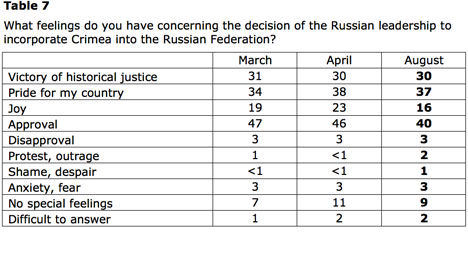
By August these figures remained all but unchanged; the approval rating fell slightly (from 46 to 39%), as did the general sense of euphoria, but the levels of protest and resentment against Putin remained stable (at below 1%). “Positive” justifications for Russian policy (“defending our people”; “the restoration of justice” etc.) superseded any discomforting concerns about the Ukrainians.
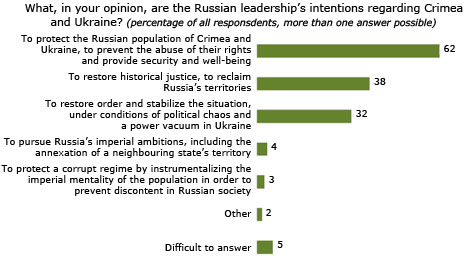
Graph 3
Phase Three: March – May 2014
At this time the situation became extremely unclear and alarming. The essential elements of a likely scenario emerged: plans to send Russian troops into eastern and southern regions of Ukraine ahead of the presidential elections and before a new legitimate power base had been formed. This was the plan to create “Novorossia”. Its completion would not only deprive the Kyiv authorities of access to the sea but would allow for the creation of a cordon sanitaire around Russia, blocking the further expansion of the EU and NATO. Anti-Ukrainian rhetoric (concerning “the Kyivan junta” and “Ukrainian punitive squads” carrying out genocide against their own/Russian people) and the financial, organizational and military support given to separatists increased sharply. Despite this, in the “independent states” of Donetsk and Lugansk – created by Moscow – propaganda aired an increasingly strident view that Russia was not only “defending Russians” in Ukraine but had returned to her traditional role as a great power. Russia was recovering her original lands and territories, lost in the recent past due to betrayal or the arbitrary rule and wilfulness of its rulers. Now that it was once again a strong country, the Russian state was compelling others to respect her interests in the Russian priority zone – the post-Soviet space. The refusal of the West to accept her actions served as ample evidence of western recognition of the restored power of the country.
In this way, the Kremlin transferred the whole weight of responsibility for the nascent civil war in Ukraine on to the western countries that had purportedly provoked the crisis in the Ukrainian state which, in turn, had sought systematically to undermine Russia and oust the country from its traditional spheres of influence and interest.

Graph 4
Phase Four in the development of the Ukrainian conflict: June to date
This was marked by: intensified clashes between a very weak Ukrainian army and separatists; attempts to cut them off from the Russian border through which they were being supplied with weapons, military technology and ammunition; an increasing flow of refugees from the areas of armed conflict; and, finally, by the destruction of the Malaysian airliner which prompted outrage throughout the world and a new wave of sanctions against the Russian administration.
The policy of Ukrainian destabilization we are seeing today is centred around the idea of discrediting the forces of democratic national consolidation and, by any means possible, transferring the focus of discontent of the Russian population from a corrupt bureaucracy to those who support the rule of law, democracy and Europeanization. Kremlin spin-doctors have the task of blocking the “expansion” and “export” of democracy and European values into Russia by representing them as deeply alien to “Russian traditions and morality”. Further, they also have to give the public an intimidating example of the destabilization that necessarily follows the overthrow of an authoritarian and kleptocratic regime. (Few people in Russia doubt that the Russian regime qualifies for this description.) This form of social demagogy has proved highly effective. The Russian population was profoundly frustrated by the collapse of institutions and the fall in the standard of living in the 1990s. The threat of social disorganization is what alarms it most.
The escalation of military action in south-eastern Ukraine is viewed by the majority of the Russian population (64-77%) as the result of western interference. Russia’s involvement, along with the direct intervention of the Russian army, is reluctantly acknowledged, but tends to be viewed in a positive way. The equivocality of the assessments themselves is not taken into account. (Over half of those polled – 55% – consider it obligatory to show support for pro-Russian forces in this region of Ukraine). One might note the bewilderment in the mass consciousness in situations where it encounters an obvious contradiction. The recognition of evident facts (for example: the involvement of serving Russian soldiers in clashes with separatists in eastern Ukraine or the use of heavy weaponry – tanks, armoured personnel carriers and anti-aircraft missile systems) flies in the face of generally accepted moral and legal norms that necessitate a renunciation of illegal force and a recognition of the inviolability of state borders. The recognitions of such facts also conflicts with the desire to express symbolic support for the actions of the country’s leadership and with the satisfaction induced by an awareness of the might and the military superiority of Russia over Ukraine’s weak armed forces. In situations of this kind public opinion tends to show signs of disorientation and confusion, as people begin to grasp that falsification is an effective tactic from the point of view of “national” or “state interests”.
Alongside all this, the Russian population is experiencing serious anxieties about the confrontation escalating into a war between two states formerly viewed as “fraternal nations and neighbours”. Consequently, an initial willingness to approve the embedding of Russian forces in Ukrainian territory is being replaced by support for a more cautious approach favouring less open forms of annexation: not to merge these territories with Russia, but to declare them a “new state”, for example (along the lines of the Abkhazian and South Ossetian model). Of respondents who knew about the idea of the creation of “Novorossia”, 38% supported the idea and 15% were against.
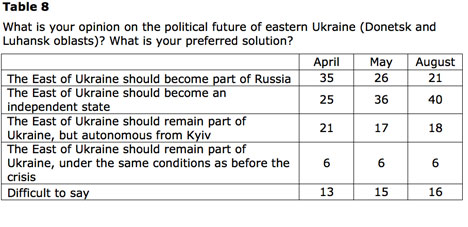
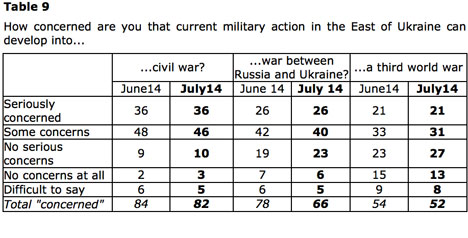
Russians are prepared to support their leadership in the event of the escalation of the conflict in Ukraine into open war, although over the past month the number of those who would support such a “decision” has fallen from 74% in March to 41% in August (and the number of those distancing themselves from this has grown accordingly, from 13% to 44%).
By August, the euphoria following the acquisition of Crimea had begun to subside. The outcomes of the incorporation of Crimea into Russia continued to be viewed in a positive way, though not to the same degree as two months earlier. Patriotic enthusiasm abated due to several factors, including a purely psychological fatigue following constant “rallying cries” of state propaganda.
But the sobering effect of sanctions has been especially important. It was initially reflected in the growth of consumer prices, inflation, and the disappearance of a whole range of products when the Russian government introduced an embargo in response to European and American restrictive measures. Only an insignificant number of Russians demonstrated a willingness personally to bear the responsibility and cost of Crimea (which is surprising especially if one considers the following responses). A willingness “fully” to carry the financial costs and implications of the acquisition of Crimea was expressed by just 5-8% of those polled; while no less than half of respondents revealed – either openly or by offering various excuses – that they did not want to bear any costs.
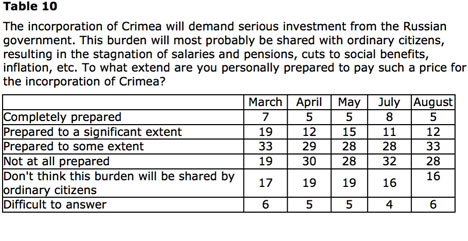
The effect of sanctions
Among some sectors of the Russian population, the introduction of western sanctions against Russia provoked a disbelief that turned to indignation. But most people were unable to grasp all the consequences of the measures that had been taken. The population judged the Western reaction to events in Crimea to be motivated by a hostile attitude to Russia, a desire to seize the moment in order to put pressure on Russia (58%), and a failure to understand the real situation in Ukraine (20%). Just 13% of those polled thought that the sanctions had been motivated by the annexation of Crimea: that is, a seizure of alien territory and the infringement of international law. (The remainder didn’t know). Discourse on the morality and the significance of international relations, law and state sovereignty, the unacceptability of using force as a way of resolving political disagreements, the acceptability of aggression or the review of borders between nations – all this was viewed by Russian society as demagogy since, to all intents and purposes, people wholly shared the position of the country’s leadership on “the rule of force”, that is to say, they were ready to participate in the political principles recognized by the USSR. Kremlin propagandists connected the imposition of sanctions with a traditional western Russophobia underpinned, they said, by a fear of the power of (a renascent) Russia, and a disinclination to see the appearance of a strong competitor. Such explanations were readily accepted by most people, who see the world solely as a battlefield between predators, where might is the equivalent of “truth”.
A number of arguments were put forward to explain why these sanctions would have no negative effect on daily life in Russia. They were not very logically connected, and sometimes totally contradictory, but they worked because their capacity to convince lay not in rationality but in two highly important evaluative premises that define the cast of mind of post-Soviet people:
a) “The West is hostile towards us”
b) “the authorities” should be responsible for politics (i.e. the decisions taken by the leadership), not ordinary citizens, little people like “us”.
The initial (not overly serious) anxiety people felt about the prospect of international isolation, or its negative effect on the daily life of the population, decreased from month to month (from 56% in March to 32% in August). An explanation for this may be sought firstly in the highly equivocal and contradictory character of the restrictive measures themselves. Secondly, it can be sought in the complete lack of understanding by Russians of the fact that sanctions are not one off declarations but a whole series of measures (political, economic, juridical, organizational) with effects that may not be instant, but which will bite over time. For the moment, they are being viewed as the usual political rhetoric – an exchange of diplomatic threats – the importance of which should not, as Russians believe, be exaggerated. The response of the Russian middle class presents an exception in this picture. Middle class people have reacted far more seriously to western actions, especially after the widening of sanctions and the retaliatory measures taken by the Russian government.5 And finally and perhaps most importantly, there is the disengagement from politics deeply embedded in the collective consciousness, and the consequent refusal of people to acknowledge any responsibility for what is happening, along with a tendency to pass the buck entirely onto those who wield power. The common phrase “we have nothing to do with all this” is a very important expression of the passive adaptation of the public to a repressive state and the crimes it commits.

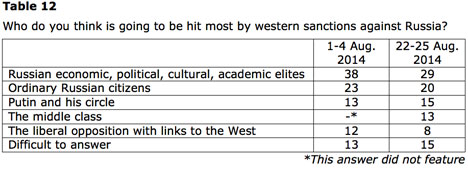
Russia’s retaliatory “anti-sanctions” – frantically introduced against countries which declared restrictive measures against Russian companies, officials, and politicians guilty of aggression against Ukraine and the infringement of its sovereignty – were supported by 72-76%. Only 12-18% of Russians declared themselves against such policies. (The remainder didn’t know.) This was irrespective of the fact that in August over 60% of Russians noted the price increases of consumer goods and the general rise in inflation.
Backing for the Putin regime’s coercive tactics in Ukraine is considerable, although there have been signs of a monthly drop in support, and disapproval ratings are growing (especially among middle class Russians who are better off, more fully informed, and understand better the negative consequences of the international isolation of the country). Over the course of three months, backing for Putin’s Ukrainian policy has fallen from 74% to 55%, while disapproval has risen from 13% to 29%.
In addition, there has been a rise in the suppressed, but nevertheless palpable, sense of a “guilty conscience”, and of the injustice shown towards Ukrainians. Recognition of the growing animosity of Ukrainians, who had previously been perfectly well disposed towards Russia, has increased sharply and become dominant (indicators of this have risen from 66% to 76%).
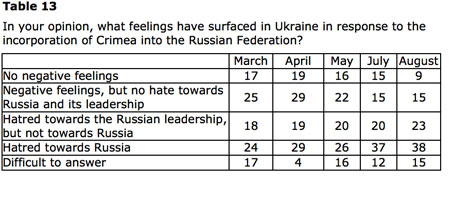
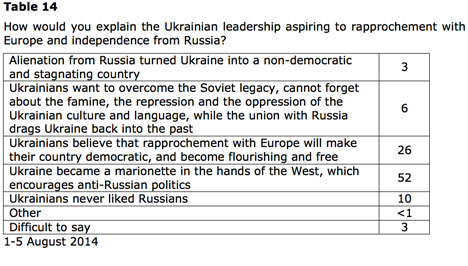
The image of the “enemy” and the legitimacy of the Putin regime
Intensified repression, along with a turnabout favouring conservative or protective policies, represent reactions consistent with the behaviour of autocratic regimes. In response to growing internal tensions, an over-centralized system of power uncontrolled by society – and therefore free of any answerability to its citizens – can respond only by seeking to destroy or at least neutralize forces which, leaders argue, provoke conflict by publicly articulating social and juridical issues born of economic stagnation and administrative dysfunction. Criticism of the regime (corruption, administrative abuses, the absence of any real protection from the arbitrary rule of the bureaucracy) destroys any hope the population as a whole may hold that the Putin state can implement the policy of social welfare that it [originally] declared to be one of its main objectives. These included: “care ” of citizens, a secured standard of living, guaranteed jobs, functioning housing and public utilities, access to social housing, free healthcare, education, pensions corresponding to a living wage, etc.
At the ideological level, there is no other basis for the legitimation of such a system of government, if one discounts other important, but different, conceptual foundations : ideas such as “the rebirth of Russia as a great power”, or the re-establishment of Russia’s “authority on the international stage”. The inertia of “imperial style” politics demands constant reiteration that the geo-political positions once held by the USSR are being maintained by Russia today.
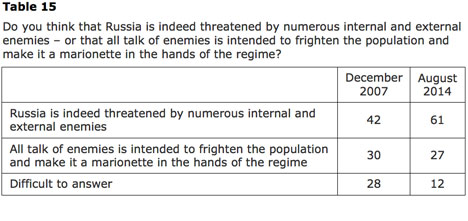
Within this system of information dissemination, the causes of the civil war in Ukraine emerge in a highly simplified, black and white form. A demonized USA is pitted against a “squeaky clean and fluffy” Russia – the defender of traditional Christian morality and values. The picture absolves Putin of any blame and gives him additional, indirect dividends as the defender of Russians who suffer injury and discrimination in all former republics of the USSR. All responsibility is transferred to faceless outside forces that are hostile to Russia (that is, to “the USA”, “the West”). The role of an external enemy is vital. “The enemy”, a perceived threat (whether real or imagined is less to the point if we are discussing the workings of mass consciousness), the existence of a “national unit”, a “collective we”, encourages consolidation around an authoritarian power centre dubbing itself “defender of the Russians”. It also removes from the agenda all questions of politics, morality and the future of the country, along with issues such as human rights and freedoms, the defects of the institutional system and democratic reforms. The extraordinary conditions that emerge when an enemy appears are paralysing for the opposition and for protest movements, because they make the issues they raise appear secondary. Equally, attitudes with regard to the population of Ukraine have been re-set. Restraints on violence towards the Ukrainian population have been lifted. Ukrainians may be treated as “sub-humans”, “enemies”; they can be denied compassion and solidarity; their problems and interests, their perceptions of events, demand no empathy (and in the long run their aspiration to join Europe, and share European values and norms, merits nothing but a deaf ear).
The issue lies not only in the conspiracy theories inherently characteristic of Soviet and post-Soviet society, or in a binary perception of reality. One must also take into account the more complex and invisible links between these representations of the West and the structure of the post-totalitarian social environment (above all the way the ordinary private individual relates to power, and especially to its personified image). Above all, there is a profound sense of the dependence of one’s personal existence on an alien but hugely powerful and malign will, an affirmation of the social inferiority or ineptitude of the individual or even of the population of the country, of an inferior society or nation, and of the hopelessness of resisting such an inhuman and – more often than not – anti-human will.6 This reflects the consciousness of subjects of the Soviet and post-Soviet state in relation to an uncontrolled and repressive power structure (an “us-and-them” connection, a numinous view of the state).
The increasing aggression that Russian society projects onto the world (alongside a sense of the “hostility” of surrounding countries) revolves around the illusion that over the past ten years respect for Russia has grown. In 2012, 25% of respondents believed this to be true, but in August 2014 the figure had risen to 44%. Meanwhile, the proportion of respondents who agreed that “respect for Russia has decreased” fell from 32% to 22%. The ambivalent and self-justifying quality of Russian public opinion ensures that any notion of responsibility for unleashing the conflict, bloodshed and military action in Ukraine – provoked and supported by Kremlin politicians – has been displaced from the mass consciousness. 75% of those polled refused to regard their country as liable for the deaths of people in eastern Ukraine, or – even more so – to recognize their personal responsibility or complicity in their killing (as against 18%).
Click on graph 5 above to enlarge
An anti-western political direction and anti-western rhetoric served as important underpinnings for a restoration of the legitimacy of the Putin regime, after it had been weakened by the protests of 2011-12. In the years immediately after Putin came to power, official discourse maintained the underlying assumptions of the previous period (under Yeltsin’s rule), that is to say: policy directed at democratic and market reforms which boiled down to a continued transformation of the legal and juridical systems, taxation, pensions, policing, and the armed forces. By 2004, however – particularly after the “colour revolutions” (in Georgia and Ukraine) and mass protests by pensioners in the winter of 2005 – the tone of the Russian leadership changed. It began to impose ideas about the salutary qualities of a return to national traditions, to patriotic values, especially in the face of the threat emerging from the West and western culture, and the nefariousness of liberal ideology and human rights. Putin expressed his vision of the confrontation between Russia and the West in a more developed way, as early as February 2007, in his speech at the Munich Conference on Security Policy. But the practical consequences and the anti-Western or anti-American thrust of Russian policy with its overtly conservative, protective ideology emerged later – following criticism of the unresolved war in Georgia, and the annexations of Abkhazia and Ossetia (which have been transformed into Russian protectorates). Putin has never ceased to regard himself as a KGB official: “a Chekist assigned to lead”, “a warrior against the enemies of the state”. He is manically obsessed by the idea that all protests by the democratic opposition are initiated by the USA, which is trying to overthrow existing regimes, and employs foreign foundations and civic organizations in the role of “foreign agents” and subversive forces in order to do so. That is why, after the huge protests that took place in Russia’s biggest cities in 2011-12 internal politics turned openly reactionary and repressive. (The demonstrations were prompted by ballot rigging in the parliamentary elections, though other more significant causes included increasing discontent with Putin’s return to the presidency, a fall in his credibility, anger at the level of corruption and cuts in social spending.) Anti-western, anti-liberal demagogy began to oppose “an increasingly degenerate and crisis-ridden Europe that has abandoned its Christian moral and cultural values” to a “resurgent Russia” demanding that its new role in the world be acknowledged. This has become a crucial feature of the Russian public’s sense of identity (which is now centred around a negative principle). Over a period of just 18 months to two years, public opinion has become openly anti-western, and predominantly anti-American (graph 6).
Click on graph 6 above to enlarge Click on graph 7 above to enlarge
In the Spring of this year, the negative mobilization of Russian society ensured that social tensions were [safely] channelled, and re-established the legitimacy of the Putin regime by transforming discontent with his leadership into hostility towards the West (and Ukraine). Soviet myths about the essential difference between “the West” and Russia”, and the inevitability of confrontation between the two cultures, have been revived along with a sense of the impossibility not only of convergence, but of “modernization” in line with western models of development. The West appears, just as it did 40 years ago, in the form of a symbolic opponent, an “enemy” posing a threat to the very existence of Russia and to Russian values, traditions and “national interests” (all of which conceals the anxiety of a despotic and corrupt leadership about maintaining power). At the same time suspicion and aggression towards the political opposition have risen sharply. To the question “Does our nation, our country, have enemies?” (in a poll taken in March 2014), 26% of respondents asserted that “our country is surrounded by enemies on all sides”. Another 30% answered: “our nation, which now stands on the path of regeneration, will always have enemies”; 20% declared that “the most dangerous enemies are hidden and internal”. Just 17% said: “why seek enemies when the roots of evil lie in our own mistakes.”7
The call to defend “our own”, the priority given to “our people and those close to us” rather than to universal norms and values, the significance of “tribal” over “human ethics”, the dominance of imperial symbols and concepts indicates a reduction of more multifaceted perceptions of contemporary society; the elimination of a complex social structure; rejection of the western system of moral, judicial, human and social interaction; and a serious over-simplification of the social picture. The ideal of a paternalistic state and of the inevitable transfer of social responsibility to the leadership of the country has once again replaced more complex configurations. Political competence is recognized only when it supports the supreme leader, the father of the nation. Vesting the leadership with absolute power offers release from moral choice and responsibility to anyone who accepts the official ideology of the regime, and the policy of military intervention in the affairs of a neighbouring country that rejects Russian domination. (“Let Putin take care of politics, not us”.) The promotion of an archaic model of social organization (as a reference point, and symbol of the unity of the country or nation) eliminates the issue of subjective personal development or aspiration, and the need to work on oneself to secure a better future. Instead there is only the present, a fact that has to be endured, with all its crude violence and amorality, alongside a reduced sense of self and of others. The apolitical position of the public, and the low level of trust in institutional structures, confound any hope that life can be changed, made more civilized and protected from the arbitrary power of the state.
Consequently, the present state of Russian society is affected by two factors: fear of NATO (now a veritable ogre in the eyes of the population – with alien military and rocket bases approaching Russian boarders, incomprehensible threats, aggressive propaganda and so on) and a sense of national relief that western demands no longer need to be met. This resolution of the traumas of Russian collective consciousness – complexes associated with low national self-esteem, a sense of the backwardness of the country, poverty, the failure of economic and social reforms, the end of the democratic transition etc. – has led not to a “healing” of [Russian] society but to a surge of relief following the break with Europe, a sense of liberation from repressive demands to be moral, to follow legal norms, to “behave” in a “civilized society”. (The notion of “civilized society” is determined exclusively by Russian ideas about the West, or Europe, as a focus of identity for an emergent culture, a representative ideal of development, modernity, prosperity etc. In the Russian language these associations lie behind the utopian idea of “normality” and the Russian expression “normal countries”). The Ukrainian crisis has licensed people to act in accordance with old standards and the culture of violence that has persisted since the days of communist totalitarianism. Hence the explosion of delight and euphoria: “Crimea is ours; we do as we please; we take no orders from anyone; we have nothing to be ashamed of; we are a Great Power.”
Levada, Yu, "'Chelovek obyknovennyi' v dvukh sostoyaniakh" ("The two states of the 'ordinary person'"), Vestnik obshchestvennogo mneniya 1/2005
The declarations of "observers" from Donetsk who had "seen with their own eyes" the pursuit of the liner by a Ukrainian fighter plane, which were confirmed by statements from the Russian General Staff, only strengthened negative attitudes towards Ukrainians, and prejudices against other version of events and information coming from the opposing side. The following versions of events circulated for a while, for example: the Boeing was shot down in error, since the Ukrainians' target was a plane carrying Putin; the Malaysian airliner was shot down after a tip-off from the Americans; the crash was a provocation engineered by the Ukrainian special services with the aim of discrediting Russia in the eyes of the global community; there had been an act of terrorism on board the plane, etc.
The same applies to the statements of OSCE observers (in line with Russian TV, the majority of those polled -- 58% -- agree that the observers describe events in Ukraine in a way that is "prejudiced, and reflects only the point of view of the Ukrainian authorities, ignoring the views of the population of south-eastern regions of Ukraine". Just 19% of the population consider the views of OSCE monitors to be "objective and impartial".
Vladimir Putin's approval rating (the difference between positive and negative evaluations) fell from 78 percentage points (in September 2008, the highest peak) to 24 points (November 2013, the lowest in the entire period of study).
In addition to the nervous response of business to the sanctions, expressed in the sharp outflow of capital from the country, the urban middle class has shown signs of anxiety. Large cities, especially urban complexes such as Moscow or St Petersburg survive mainly on the import of consumer goods, primarily groceries. The prices of which have risen sharply. The impoverished provinces (two thirds of the population) consume mainly local produce and are less affected by fluctuating prices and imports. In all, just a quarter of respondents admitted that sanctions might cause problems for them and the lives of their families.
Hence the importance and effectiveness of the narrative promoted by Russian propaganda that, in the Maidan, those who had taken control were supporters and fighters from the extreme nationalist and radical Pravyi Sektor (Right Sector), Svoboda ("Freedom'), Banderovtsy, fascists etc. The key word here is "fascists". It activates the vocabulary of the World War II, the memory of the death of millions, and the associated suffering and destruction. This alone breaks all bonds between Russians and Ukrainians. It destroys the possibility of identification, empathy and understanding; of compassion, solidarity, and common interests relating to gaining freedom from corrupt authoritarian regimes. It precludes the establishment of the rule of law and of a democratic state in which infringements of human rights, arbitrary rule and plutocracy are unacceptable.
When we first put this question 25 years ago -- in 1989 -- 47% of those polled selected this response.
Published 1 October 2014
Original in Russian
Translated by
Irena Maryniak
First published by Eurozine
Contributed by Transit © Lev Gudkov / Eurozine
PDF/PRINTPublished in
In collaboration with
In focal points
Newsletter
Subscribe to know what’s worth thinking about.
Related Articles

House keys recur in the stories of Crimean Tatars and Palestinians displaced from their respective homelands in the 1940s, and Ukrainian citizens fleeing Russian invasion since 2014. Ethnographic research and discourses on art and justice show how objects emblematic of home salvage the history of exiled peoples from oblivion.

As capital consolidates, culture recedes, funding vanishes, access narrows. The question persists: why fund culture at all? Cultural managers from Austria, Hungary and Serbia discuss.

